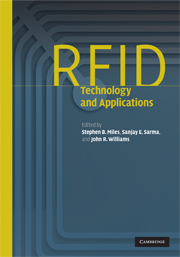Book contents
- Frontmatter
- Contents
- List of contributors
- Preface
- Acknowledgments
- 1 Introduction to RFID history and markets
- 2 RFID technology and its applications
- 3 RFID tag performance optimization: a chip perspective
- 4 Resolution and integration of HF and UHF
- 5 Integrating sensors and actuators into RFID tags
- 6 Performance evaluation of WiFi RFID localization technologies
- 7 Modeling supply chain network traffic
- 8 Deployment considerations for active RFID systems
- 9 RFID in the retail supply chain: issues and opportunities
- 10 Reducing barriers to ID system adoption in the aerospace industry: the aerospace ID technologies program
- 11 The cold chain
- 12 The application of RFID as anti-counterfeiting technique: issues and opportunities
- 13 Closing product information loops with product-embedded information devices: RFID technology and applications, models and metrics
- 14 Moving from RFID to autonomous cooperating logistic processes
- 15 Conclusions
- Appendix – links to RFID technology and applications resources
- Editor biographies
- Index
- References
1 - Introduction to RFID history and markets
Published online by Cambridge University Press: 02 November 2009
- Frontmatter
- Contents
- List of contributors
- Preface
- Acknowledgments
- 1 Introduction to RFID history and markets
- 2 RFID technology and its applications
- 3 RFID tag performance optimization: a chip perspective
- 4 Resolution and integration of HF and UHF
- 5 Integrating sensors and actuators into RFID tags
- 6 Performance evaluation of WiFi RFID localization technologies
- 7 Modeling supply chain network traffic
- 8 Deployment considerations for active RFID systems
- 9 RFID in the retail supply chain: issues and opportunities
- 10 Reducing barriers to ID system adoption in the aerospace industry: the aerospace ID technologies program
- 11 The cold chain
- 12 The application of RFID as anti-counterfeiting technique: issues and opportunities
- 13 Closing product information loops with product-embedded information devices: RFID technology and applications, models and metrics
- 14 Moving from RFID to autonomous cooperating logistic processes
- 15 Conclusions
- Appendix – links to RFID technology and applications resources
- Editor biographies
- Index
- References
Summary
The market for radio frequency identification (RFID) technology is growing rapidly, with significant opportunities to add value, but also, because of the challenging issues that are identified in the chapters that follow, many opportunities for failure. This book brings together pioneering RFID academic research principals to analyze engineering issues that have hampered the deployment of RFID and to share “best practices” learnings from their work, building on the tradition of the Auto-ID Labs. The Auto-ID Labs consortium of leading universities around the world includes Auto-ID Labs at Cambridge University, Fudan University, Keio University, the University at St. Gallen and the ETH Zürich, the University at Adelaide and, most recently, the ICU, South Korea. The principal investigators represented here have conceived, obtained funding for, and executed research projects using RFID technology. The authors share their experience in the design, test, prototyping, and piloting of RFID systems, both to help others avoid “reinventing the wheel” and to set the stage for what is next in RFID.
Because RFID technology has evolved from proprietary systems operating at different frequencies in jurisdictions with different RF regulatory restrictions, most RFID work has been divided into communities operating at one frequency or another. In RFID Technology and Applications we bring together principal investigators with experience in passive RFID systems across a range of frequencies including UHF 860–960 MHz (EPC GenII/ISO 18000–6c) and HF 13.56 MHz (ISO 18000-3), but also, breaking with precedent, we include experts in active (with power) RFID systems.
- Type
- Chapter
- Information
- RFID Technology and Applications , pp. 1 - 15Publisher: Cambridge University PressPrint publication year: 2008
References
- 3
- Cited by



